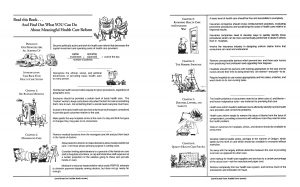Note: Even back in 1992 when we wrote Modern Medicine, the focus of patient care had become the patient’s chart, not the patient. Because there were no longer enough ward clerks to do the paperwork on a hospital floor, the nurses had to do it—at the expense of attending to patients. Can’t say whether the “primary care” nurse concept came out of the attempt to do without the ward clerks and orderlies, or vice versa, and it doesn’t really matter. Nurses at that time seemed enamored of the notion of “primary care,” of being in charge of a broader spectrum of care for “their patients.” As I mentioned in the introduction to these seven myths about health care costs, Modern Medicine angered nurses more than any other group, including lawyers (which we figured we would have offended the most). The public relations effort to promote the notion of the “primary care” nurse had been very effective, nurses loved the concept, and no one was willing to look at the consequences to the patients. And we still here the mantra “shortage of nurses.” So the movement of the caregivers attention from the patient to the chart began a long time ago with the exit of ward clerks and orderlies from hospitals along with the introduction of the notion of nurses having “their patients” instead of sharing the care of a patient with other nurses and staff has led to the notion that nurses are scarce. It’s an artificially created scarcity caused by the disappearance of ward clerks and orderlies. When electronic medical records came along, the shift from patient to chart had already occurred. Electronic medical records bring a wealth of good things to medical care, but the time it takes to enter the data into patient records seriously impairs the ability of nurses—or physicians—to concentrate on providing needed care to the patients.
 Click on the image to open it enlarged in a new tab.
Click on the image to open it enlarged in a new tab.
Myth #3
There is a nursing shortage.
Truth:
There are more nurses per capita today than ever before.
Discussion:
In efforts to contain costs, many hospitals have reduced their staff by decreasing the number of aides and orderlies who do the less skilled tasks. With fewer aides and orderlies, nurses are expected to assume these roles.
When Dr. Lindemann worked as an orderly in a rehabilitation hospital 40 years ago, he had 45 patients, from paraplegics (paralyzed from the waist down) and hemiplegics paralyzed on one side) to quadriplegics (paralyzed from the neck down). The facility had one registered nurse, one licensed practical nurse, and about seven aides and orderlies.
As an orderly, Dr. Lindemann was responsible for five to seven patients. When he first got to work, he had to get fresh water for all his patients and do vitals on them, including temperatures, blood pressures, and pulses, and repeat the vitals at bed time. He was responsible for bowel programs, bathing, and turning patients.
As an orderly, He was paid $1.15 an hour and had no benefits. He wasn’t paid for overtime. If he was one minute late for work, he was docked a quarter of an hour. He usually worked 8.5 to 9 hours without a break. As he says, he thought work was a thing to do, not a place to go.
At the rehab hospital where Dr. Lindemann worked all those years ago, it would have taken eight registered nurses (RNs) to cover his shift if the aides and orderlies had been let go.
Solution:
Reassign non-essential care-taking duties to other employees so RNs can focus on what they do best—providing skilled, hands-on care to patients.


